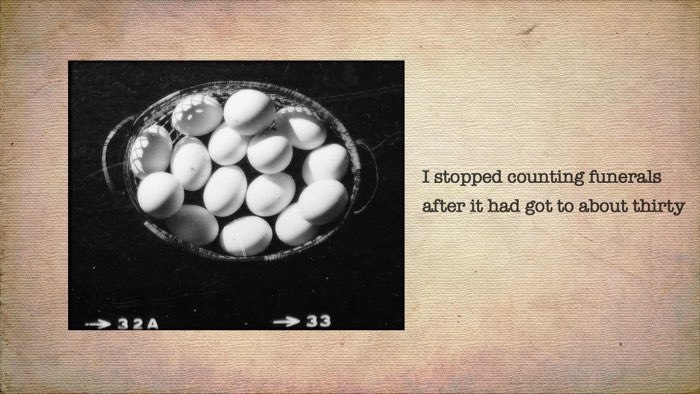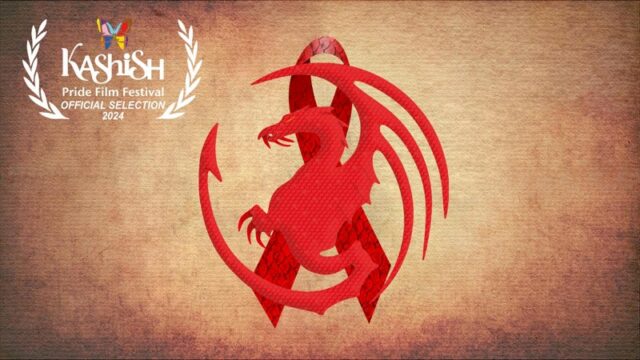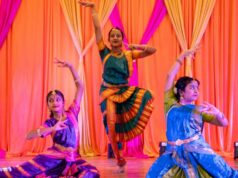SLEEPING DRAGON
12 min | 2023 | UK | English
Director: Rob Falconer
Director Rob Falconer returns to KASHISH with a short documentary that brings a beautiful snapshot of George Hodson, an artist, writer, and long-term HIV/AIDS survivor to vivid life. Those of you who watched Legendary Children [All Of Them Queer] at last year’s festival will undoubtedly recognise George.
The film is a piece that you have to adjust to when you watch it. It takes a while to sink into the rhythm and pace. The visuals are stylised, including some of George’s art and photographs, backed by a well-chosen voice to narrate. At only 12 minutes long, it can barely scratch the surface of George’s life and struggles, but the material has been well chosen and it’s hard not to be drawn in and emotionally involved. Audiences in the UK that have seen it have reportedly been brought to tears.
Drawn to George
I was curious as to why, after directing Legendary Children, what had attracted Rob to concentrating on George Hodson to create Sleeping Dragon.
“I met George while shooting Legendary Children. There he was, right up at the head of the Pride 50 march with Peter Tatchell and Tom Robinson, and of course George had Moomin and Lily (his two Griffon dogs) with him – those dogs are two of the most experienced LGBT+ rights protestors I know! Well I was in love, straight off,” explains Rob.

“We shot some brilliant footage with George. He said to me, ‘Well, you only came up to me because of the dogs, dear’ and flipped me the bird. I was mortified that I’d offended him, and then I saw the wicked laughter in his eyes. Photographer Chris Jepson caught that in his photo of George. Perfect, look at it and that’s George. He could be so naughty. We made an instant and pretty deep connection.” Later on, Rob got to see George’s artwork and also some of the book manuscript he’d been working on with Adam Zmith. Rob knew that the book had to be a film too and began work on Sleeping Dragon.
The real challenge was how to distill such an amount and variety of work into such a small package, but Rob had a vision. “It had to be human, emotional, totally surreal, all the wonderful things George could be. A screen concept started to write itself in my head really quickly, his unique writing just leads you that way,” says Rob. “If anyone makes comparisons to Derek Jarman’s Blue (which they have) we’ll take that as a massive compliment.”
However, the best review Rob could have hoped for came from George himself. “He burst into tears when he watched the first rough cut of it. I thought I’d really blown it, but they were tears of pure joy it turned out.” Sadly, before the film was finished George passed away, but this brought a new dimension to Sleeping Dragon. “Losing him in 2023 changed the film again. It was painful, so many adored him. But in a bizarre way he kind of gave it the extremely powerful ending it has now – because he wasn’t there with us any longer, but finally back with Sam.”
Hopes for an Asian audience
Sharing George’s story and amazing survival with HIV through the times when the survival rate was so low, is inspirational. Rob is convinced that KASHISH 2024 being able to bring it to India is a great first step. “India alone is a huge subcontinent, South Asia an ever wider territory with the LGBTQIA+ populations really beginning to find their voice now. HIV wreaked a terrible cost on South Asian lives. Health inequity, and access to what modern HIV therapy can do remains a very serious problem,” says Rob.

He’s not worried that the message won’t travel between cultures, because he believes that although the cultural background and issues in Asia are very different from the challenges LGBTQIA+ people have had to contend with in the UK, some things are universal. The desire to say “Here we are, this is who we are. Deal with it because we’re not going away. We’ve been amongst you for centuries” is an example Rob gives.
George also had a deep connection with Asia. The love of his life, Sam, was Thai and they lived in various parts of South Asia. “When they were both eventually diagnosed HIV positive back in the UK, Sam went on the highly controversial Concorde AZT trial. George didn’t want him to, it was highly dangerous (and killed him) but Sam felt it his duty to try, for the many in Thailand who weren’t even getting that chance. South Asia’s presence is written into George’s amazing history, and in to this film. It had to come to KASHISH,” says Rob.
A legacy for the future
“We are fortunate to have this beautiful tribute to George, in Sleeping Dragon,” says Adam Zmith who was George’s writing partner and editor on the book which Rob dramatised part of to make Sleeping Dragon. “Rob has put together a tender film with love and tenacity, drawing on George’s writing, his artwork, and the broader theme of survival.”
Adam believes that the documentary will serve future generations well. “We are losing our queer elders like George, including those who survived the HIV pandemic, and it is vital that we remember everything they went through and fought for,” he says, “Sleeping Dragon is a portrait of a proud, swishing queen—and a tribute to his generation that we need to carry with us.”

KASHISH 2024 will certainly help get Sleeping Dragon in front of an audience, but what does Adam feel that viewers will gain from watching it? “I hope that people watching Sleeping Dragon will understand what George’s generation went through: the homophobia, the stigma and the pandemic. We are living in an era where HIV is controllable and we even have the means to stop its transmission between people (these benefits are still far from available to everyone). But even though we have these miracles, we must remember where we’ve come from, and honour those who fought so hard for what we have today. So, I hope that audiences get to know who George was, and also the contribution of members of George’s generation.”
Having watched the documentary, I can attest to how effective Sleeping Dragon is at creating a feel for some of George Hodson’s work and life. Rob hopes it will be seen by a large audience around the world. “George and I made this to be seen by groups of people in a cinema, an exquisitely affecting human journey he alone takes them all on together,” says the director. “What will always gut me is that he never got to see it with a live audience in a big theatre.”
Sleeping Dragon was debuted in April to a capacity crowd at London’s Barbican Cinema, along with Rob’s new Director’s Cut of the landmark HIV film Gay Man’s Guide To Safer Sex ’97 to mark 40 years since the discovery that HIV was the actual cause of AIDS. “George simply stopped time in that theatre. He will again,” says Rob, “That book has to be published. Moomin and Lily, I’m delighted to say, are very definitely still with us and living with one of George’s dearest friends now, and the line of champion Griffon dogs George started goes on too. He’ll never really be gone.”
Sleeping Dragon will be shown on May 16 at Liberty Cinema, Mumbai. For more details go to our article about Documentary Panorama.
Voted as one of the Top 5 LGBTQIA+ Film Festivals in the world, KASHISH Mumbai International Queer Film Festival is South Asia’s biggest queer film Festival and the first LGBTQIA+ film festival in India to be held in a mainstream theatre.
Founded in 2010 and held every year for the past seven years the festival has grown from strength to strength. KASHISH attracts close to 8500 footfalls every year over its five day festival. It is the first Indian LGBTQIA+ festival to be held with the approval of the Information & Broadcasting ministry, Government of India.
The festival also attracts topline Bollywood celebrities, filmmakers, critics and academicians from India as well as many international guests from across the world.
For more information go to: https://mumbaiqueerfest.com/
Jonathan has a varied history, having written for publications such as Asian Woman but also technical magazines such as Networking+. He also has a background in IT so he's been instrumental in the technical side of getting Global Indian Stories launched. As co-founder, he also keeps writing, sub-editing, and handling the social media.


![Powerful Pride documentary Legendary Children [All Of Them Queer] streaming very soon](https://globalindianstories.org/wp-content/uploads/2025/06/Legendary-streaming-release-featured-238x178.jpg)



![Powerful Pride documentary Legendary Children [All Of Them Queer] streaming very soon](https://globalindianstories.org/wp-content/uploads/2025/06/Legendary-streaming-release-featured-100x75.jpg)

